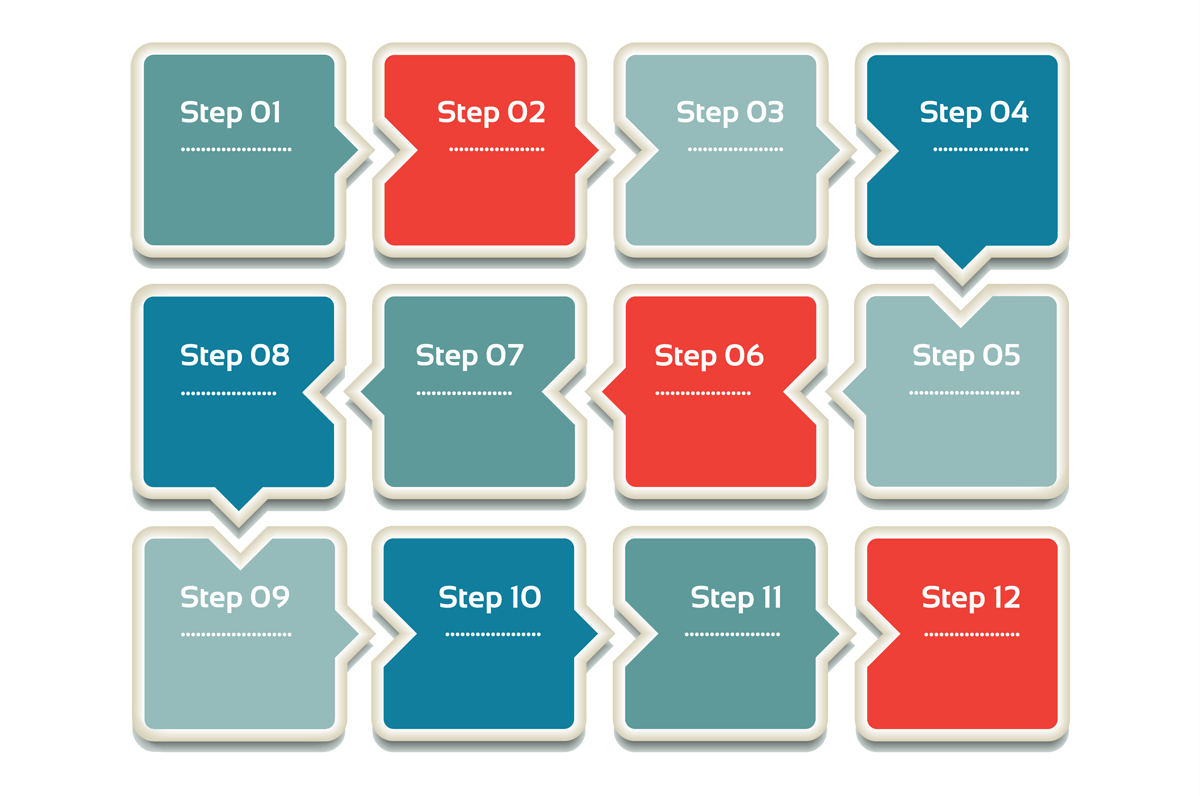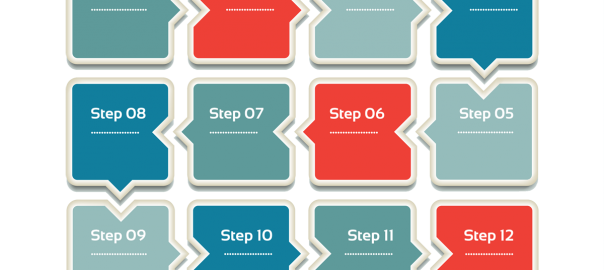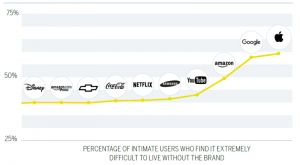— September 12, 2017

Digital marketing can be daunting. And keeping up with trends and shiny objects is exhausting and usually a waste of time. Sometimes, you need to get back to what works.
These are things we tell our clients all the time so it only made sense to assemble a list.
Here are 12 steps to take that will help you succeed with your digital marketing (in a somewhat particular order)…
1 – Critique your website
We’re always looking to improve ourselves – lose weight, eat healthier, make more money, etc. The best way to achieve these goals is to first identify our bad habits through honest self-examination.
Your website should have goals too – get more traffic, convert more traffic into leads, etc. To achieve these goals you’ll first need to critique your site and identify those “bad habits.”
Make an honest and objective appraisal of the quality of your site’s design, structure, content, calls to action, etc. You’ll need to look at your site statistics (Google Analytics) to see which pages are popular and which sections of the site need some love.
Think of this as the equivalent to sending your site to a shrink for some deep analysis. Sometimes you might be too biased to make an objective assessment. If so, consider bringing in a consultant.
Or you could ask a handful of clients to critique your site. If you ask clients, make it easy for them. Put together a survey they can fill out online within a few minutes, and make sure you ask them what would make the site better for them. Either way prepare to be surprised by the results.
2 – Develop target keywords
Some will argue that this is the first thing you must do before engaging in any sort of online marketing. Be that as it may, it is simply important that you DO have a list.
As you engage in any online marketing activities – blogging, social media marketing, email marketing, white papers, video, eBooks, etc – you will want to have a list of targeted words and phrases that are important to you AND your clients. They are important in the sense that these are the words and phrases your clients use to find you in an online search.
There are a few ways to go about developing this list. You will again want to take a look at your site statistics to see what words visitors to your site are using to find you. You will also want to do some searches on those words and see what the competition is doing. I am over-simplifying a bit of course.
There are lots of articles out there telling people that keywords lists are a waste of time. And they are right, if… if you just write a list of words you think you need to target and do zero research, then yes, you are wasting your time.
Instead, spend some time looking into what words and phrases your competitors rank for (SEMRush, MOZ). And think about long tail keywords, and words with fewer search results (a target rich environment).
There are many resources out there to help you with this process. For the purposes of this article, I will leave you with some suggested resources…
3 – Develop a content strategy
If you haven’t read Content Rules by Ann Handley and CC Chapman, do so, soon. In this book you will find a very easy to follow overview of content marketing. In online marketing, content is king and content marketing is the king’s horse.
On today’s internet the companies that offer valuable information to users where they are seeking it are the clear winners. If you are a sought after resource online, you will get leads and your site will get traffic.
Content marketing is how this is done. Write blog posts that empower the user. Shoot video that educates and entertains. Create presentations and host webinars that inform. And you do these things through your channels – your website, your blog, your social media channels, etc.
But before you do any of this, you want to have a strategy. Once you have looked through your existing site (and ripped it apart) and identified the needs of your target audience, you’ll be able to better identify what content you need to create and where you should post and promote that content so it’s easy to find.
Some other resources that will help you with your content marketing efforts are these incredibly useful blogs…
And here are some other books on content marketing that I recommend…
- Content Code
- Content – The Atomic Particle of Marketing
- Everybody Writes
- Epic Content Marketing
- They Ask, You Answer
4 – Eliminate bad content
Hopefully as you review your website and your site statistics and develop an effective keyword list, you will realize that some of your content has got to go. Maybe it’s a page that gets no traffic because it’s out of date, poorly promoted or just plain wrong. Instead of putting “lipstick on a pig,” try a radical approach… get rid of it.
Bloat used to be OK. For some search engine professionals (who shall remain nameless), it was part of a content strategy. Not anymore.
It is much more effective to think about all content as it relates to the intended user. If it serves them no purpose or – worse yet – confuses or misinforms them, get rid of it. Pretty simple.
5 – Rewrite old content
Of course not all of your old content is completely useless. There could be old blog posts, white papers, case studies, etc that still hold some relevance. Instead of eliminating them simply because they’re old, why not try and re-imagine them (h/t to Content Rules).
Take a fresh look at old content. Perhaps try rewriting it or leave the original content and add to it. Think about a news story online. Sometimes news sites will leave the original story for context and then offer updates below.
Or maybe you can string related posts together into a valuable eBook. Or you could turn it into a video like we did with this post about responsive design.
Again, consider the user. What is the best way to rework this old content in a way to better serve a client.
6 – Develop an editorial calendar
Are you overwhelmed yet? Don’t be. These are tasks that can be easily integrated into your marketing and communications workflow (there really is no other choice). The key to success is to map this all out.
This can be done using what’s called an Editorial Calendar. Here is a post from the Content Marketing Institute that really lays this out nicely… Editorial Calendar Tips, Tools, and Templates.
Mapping out your content marketing efforts in advance will allow you to see the bigger picture. It will also help you to set deadlines. If you commit to content marketing for your organization but make no written outline of the what’s and when’s, you will fail.
If you treat this like a regularly scheduled task that is just as important as say paying the rent, you will see results.
7 – Start blogging
Blogs are no longer just for bloggers. You don’t have to have aspirations of becoming an internet blogging sensation. You just need to know the needs of your target audience and write to those needs.
You’re sitting on a mound of expert information that you need to share. Don’t believe me? Read this post about business blogging.
Or, simply look back through your email inbox, notepad, sales materials, presentation materials, etc. You talk to your clients every day (members and volunteers are clients too if you live in that world).
Be the same expert in a blog that you are every day in the real world. You will benefit from an SEO standpoint because of the useful keyword rich content you’re adding to your site. You will position yourself as an authority in your field which also has an impact on your search rankings.
And you will steadily be “out there” talking about what it is that you do.
8 – Embrace social media
As you engage in a content marketing strategy, you will quickly realize that blogging, video, online presentations and the like NEED social media. You also need social media. Why? This is where your clients are. Yes, they are, trust me. The numbers do not lie.
That said, there are going to be some differences from group to group as to where they prefer to spend their time. So, take a little time and look around. They may be on Facebook, Twitter, LinkedIn, or in lots of different places.
As an example, let’s use LinkedIn…
Are your clients spending time in LinkedIn discussion groups? Yes? Share your blog posts with them, along with posts from other experts you think would be of value to them. Most importantly, engage them. Talk to them and have meaningful discussions.
Read this very short yet powerful post from Seth Godin to see what I mean here – One option is to struggle to be heard whenever you’re in the room…
9 – Read
There is so much content out there. Go and find it, devour it and report back. There are books of course. Personally, I love my Kindle and it is loaded with books on marketing, social media, web design, etc. But, I also subscribe to a bunch of blogs and I check my email every day for Google alerts.
I guarantee you that there is at least one blog out there that is filled with great information about your industry. Chances are there is more than one. The key is to find them and set some time aside each day or week to read the posts that catch your eye. And then report back to your followers, subscribers, etc. on what you’ve read and how it could help them.
Reading is fundamental. It’s fundamental to your continued success. It keeps you in the game with a fresh perspective on what it is that you do. Start by setting some Google Alerts using the keywords from your list (see above). This way, you are guaranteed delivery of content related to those terms.
You’ll have to sort through some junk, but eventually you’ll find some sources of great reading material and, therefore, wonderful inspiration. And subscribe to the usual suspects that show up in your alerts – the blogs and sites you go to time and again.
10 – Update your design
Yes, design still matters. If you think design doesn’t matter, you must dress in the same gray clothes, drive the same gray car and all the walls in your house must be a shade of off-white. Let’s face it, we judge things on some level based on their looks.
If your site looks old and tired, you look old and tired. If your site looks out of touch, you look out of touch. And if your site is boring and uninspired… well, you get the picture.
Try sprucing things up a bit. Maybe it just needs a little curb appeal. Maybe it needs an extreme makeover.
Either way, I am willing to bet there is always something you can do to improve the look and thereby improve the user experience of the site.
11 – Take the keys from the intern
I’m not sure when and why it became acceptable to give all digital marketing tasks to your intern or part-time summer help. I like interns, I think they serve a great purpose. We even hired one full-time.
But, do you think they really should be the ones managing your brand and your online reputation? If you task them with managing your social media or your blog or your email newsletter, that’s exactly what’s happening.
Take control. At the very least monitor what the intern is doing, but even then, you really want to be much more involved than that. This is the front line. This is where the meaningful connections are made. I would not leave this up to the intern.
It’s your voice that matters. This is what your clients want. Not the musings of someone who may or may not be there in a month’s time.
12 – Be a resource
We’ve been saying this since day one, literally. Our very first article (before we and everyone else had a blog) was titled “Turn Your Website into a Resource”. It’s still true today. As I’ve said already in this list, you are already an expert, be that expert online.
But don’t just be the expert that tells everyone what to do. Be the expert that everyone looks to for guidance, for the best information and for thought leadership. Do that by creating your online expert persona. Being a resource means you share anything that your readers, followers and fans would find useful, even if it’s from a competitor.
Maybe you’re doing many of these things already. It’s just time to fine-tune your efforts to get the maximum return from your online marketing efforts. If you are struggling to find business, maybe it’s because you’re not “out there” enough.
I hope you got something from this list. If you are doing any or all of this already, good for you! Keep it up! If not, what are you waiting for??? This is the new norm! It’s time to embrace online marketing, content marketing and social media because it’s not going anywhere and more importantly, it works!
Did I miss anything? Let me know in the comments below…
Digital & Social Articles on Business 2 Community
(73)






